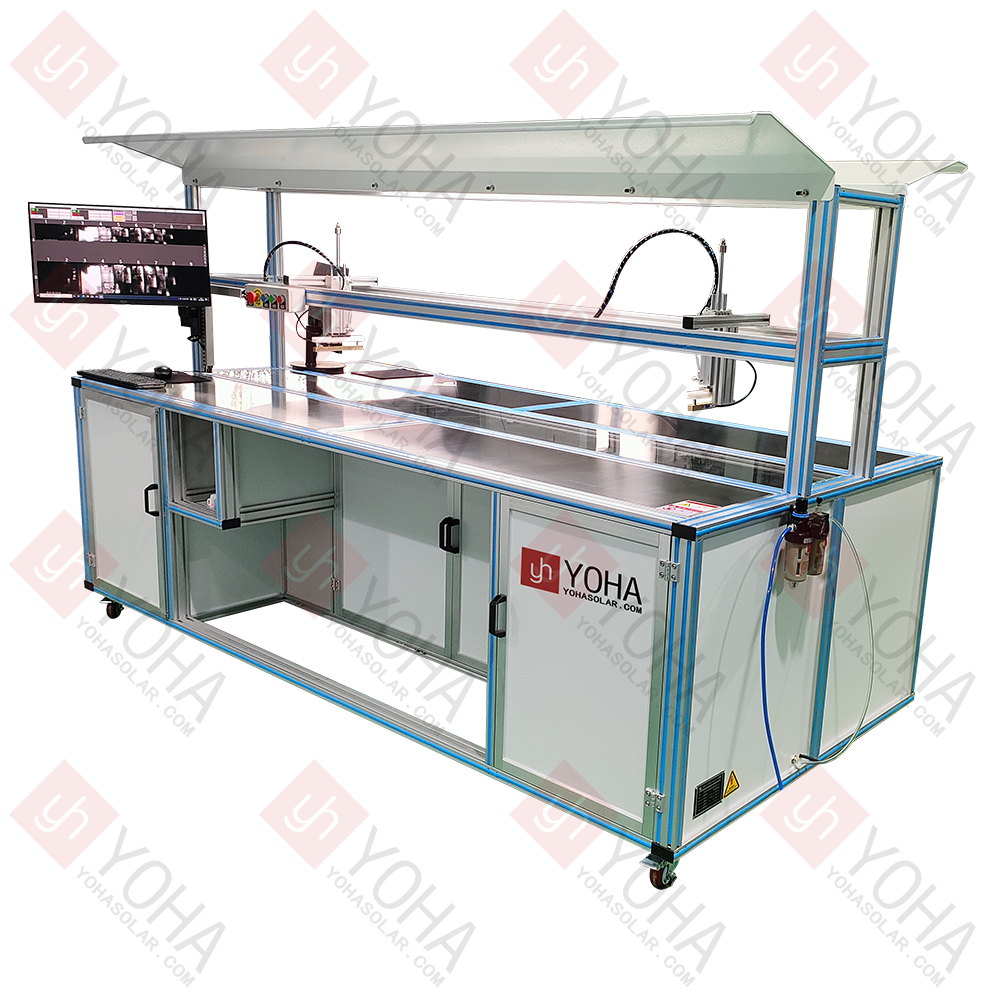Welcome to Wuhan Yoha Solar Technology Co., Ltd!
common problem
Site Map
Language:
 Chinese
Chinese
 English
English
Welcome to Wuhan Yoha Solar Technology Co., Ltd!
common problem
Site Map
Language:
 Chinese
Chinese
 English
English
The Solar Cell String EL Defect Detector is an automated online or offline inspection device based on the principle of Electroluminescence (EL). It performs high-sensitivity imaging on solar cell strings under forward bias voltage, enabling efficient, comprehensive, and non-destructive identification and localization of various internal defects within the string (such as micro-cracks, fragments, finger interruptions, cold soldering, sintering defects, low-efficiency cells, black heart cells, process contamination, etc.). It serves as a key quality control tool for enhancing the production yield and long-term reliability of photovoltaic modules.

Non-destructive Testing Based on Electroluminescence (EL): The core of the device utilizes the Electroluminescence (EL) principle to perform high-sensitivity imaging on cell strings under forward bias voltage in a darkroom. The entire process is completely non-destructive, causing no physical damage or performance impact to the cell string itself, ensuring the integrity of the inspected product.
Comprehensive and Precise Defect Identification Capability: Equipped with a high-resolution imaging system and intelligent image analysis algorithms, it can efficiently and accurately detect and locate various subtle internal defects in cell strings, including micro-cracks, fragments, finger interruptions, cold soldering, poor sintering, black heart cells, low-efficiency cells, process contamination, PID, etc., covering major quality issues during production.
Automated High-Efficiency Online/Offline Detection: The device is designed for high automation, seamlessly integrating into production lines (online) for high-speed, continuous inspection, significantly improving production cycle time; it can also function as an independent workstation (offline) for sampling inspection, process validation, or laboratory analysis. It markedly reduces reliance on manual labor and enhances inspection efficiency and consistency.
Key Tool for Enhancing Yield and Reliability: By quickly identifying and rejecting defective products at an early production stage (cell string stage), it effectively prevents defects from flowing into subsequent module encapsulation processes. This not only directly improves the final yield of module products but also ensures the long-term power generation performance and reliability of PV modules. It is an indispensable quality control checkpoint in photovoltaic manufacturing.
| Item | Specification |
|---|---|
| Model | YHEL-2520 |
| Applicable Process | Pre-lamination solar cell string defect detection |
| Test Specification | Mono-crystalline, Multi-crystalline solar cell strings |
| Camera Type | Dedicated Industrial Camera |
| Resolution | EL: 2.3 million × 4 pixels |
| Shooting Mode | Four-camera mode |
| Sensitivity | Capable of detecting cracks with width less than 0.03mm |
| Effective Testing Area | 230 × 2520 mm |
| Regulated DC Power Supply | 60V/10A |
| Image Acquisition Time | 1~60s (adjustable) |
| Power Supply | 220V/50Hz |
1、High Voltage Safety Protection: Ensure the device is well grounded before operation. Power off before touching the cell string to avoid electric shock risk. Disconnect power before moving the solar cell string after testing.
2、Darkroom Environment Guarantee: Testing must be performed in a strong light-free environment. Any light source interference (including red light) is strictly prohibited. Regularly inspect the dark box door seal to prevent light leakage affecting imaging quality.
3、Clean Cell Surface: The surface of the tested cell string must be free of dust, water stains, and fingerprints, otherwise EL images will show artifacts. Wear cleanroom gloves and use dedicated lint-free cloths for cleaning.
4、Avoid Mechanical Damage: Handle the cell string gently when placing it; avoid pressing or bending. Position fixtures must be adjusted to the appropriate tightness to prevent squeezing that could cause micro-cracks.
5、Compliant Parameter Setting: Current/voltage parameters must strictly match the cell string technical specifications. Excessive current will exacerbate defects, while insufficient current will result in unclear imaging.
6、Regular Calibration and Maintenance: Calibrate the CCD camera photosensitivity and infrared filter quarterly, and clean lens dust. The cooling system requires maintenance to prevent increased camera noise.
TOP
18086473422
MESSAGE
